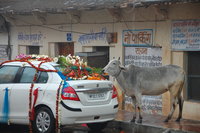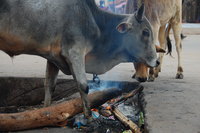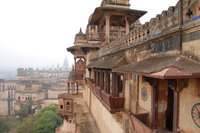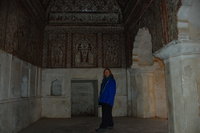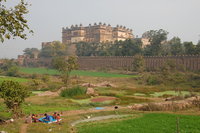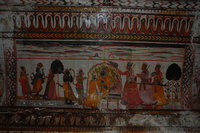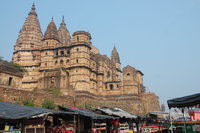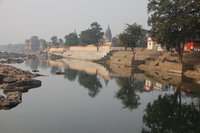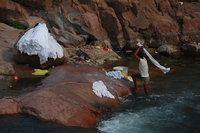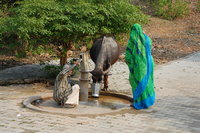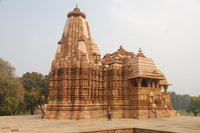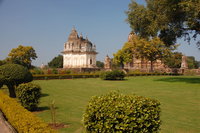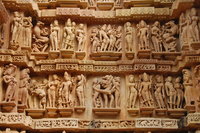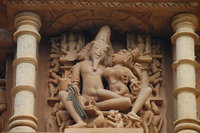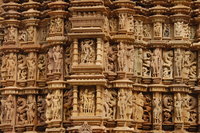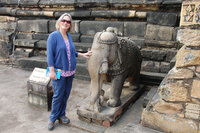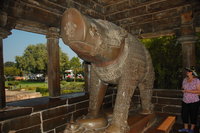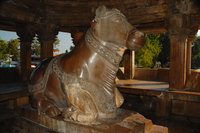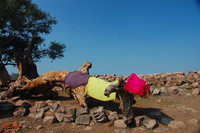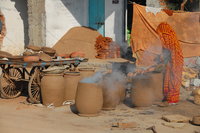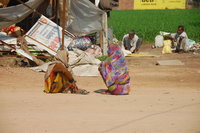So, on departing Jaipur, we took the train to Jhansi. Train number 19666 (there's a clue in the name) was billed as taking 8 hours; in the end it took a bit over 11 hours, meaning our 6am departure put us in Jhansi at around 5pm. We had a backup plan to spend the night in Jhansi before taking the 20km onward ride by auto-rickshaw to Orchha the next morning. This would avoid a relatively lengthy rickshaw ride in the dark (not a highly survivable option). In the end, we decided to go for it and try and make Orchha before sundown. Steve selected a tuk-tuk driver at Jhansi station on the basis that he looked old and was likely to drive quite slowly. Unfortunately, with age must come psychic abilities because this fellow immediately picked up on our desire to arrive before sundown and took it upon himself to set a new Jhansi to Orchha record. Upon arrival in Orchha it became clear that he knew neither our hotel nor any English, but he did kindly take us to every establishment in town and thus, by a process of elimination, we eventually reached our destination in one piece (physically if not mentally). The sun was just setting.
Arriving a day early in Orchha threw the hotel owners a bit, but they were welcoming and accommodating once they had figured out who we were. In hindsight, perhaps we did confuse them a bit as, when we ate in their restaurant the first evening, they proved themselves to be the only people in India who couldn't cook rice. We clarified with them that the only difference between our £6.50 a night room and the £12.00 ones was the presence of air conditioning (not needed at this time of year) and a fan heater. Rather than upgrade, we simply asked for a heater and offered to pay £1.00 for it. Everyone seemed happy with the arrangement, especially Megan!
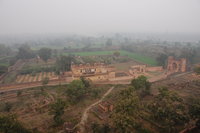
Orchha is a small town that the locals describe as beautiful, but which we have learned by now really means "could be worse". In fairness, some streets are actually fairly clean and, when we inquired about this, we were told that the area council office is located in the cleanest of these streets - weird eh? The town is rapidly becoming famous for its large collection of ruined medieval palaces and temples and, since it is conveniently situated en route between Rajasthan and Varanasi, every day around lunch time tour buses arrive and the town springs to life for a couple of hours. Colourfully decorated "priests" and "holy men" appear for the duration, only to miraculously disappear again when the coaches leave. Outside this time, there are a few die-hard gringos lurking around the ruins and keeping the restaurants in business, but otherwise the place is pretty sleepy. Disturbing the relative peace is the young lad with the tuk-tuk fitted with an extraordinarily loud sound system who races up and down the main (only) street thumping out industrial techno "music".
Apropos inappropriately loud music, quite often we have been settling in to a hotel in the evening only to be suddenly barraged by thumping dance music. After running the gamut of emotions from mildly amused through irritated to downright livid at the racket, we always find that it stops after only about half an hour or, in any case by 10:30pm. Any self-respecting rave would, of course, still be in full swing at about 6am the next day. Investigation revealed that these were always wedding parties. It is left to the reader to imagine be-saried Indian women throwing shapes on the dance floor. The Indians certainly have more full-on weddings than any we have ever attended in the UK.
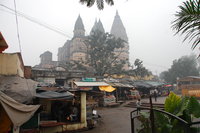
One rather shocking aspect to Orchha (that will please those of you in the UK who have been complaining about all the blue sky in our photos) is that we had rain all the first day. Just to clarify, that's the first rain we have seen since we left the UK and Steve finally discovered that his waterproof shoes aren't. We trudged along streets now covered in slurry and sat in cafés under tarpaulins that filled with water, drinking our favourite hot lemon, ginger & honey concoction. It was cold and damp; the locals lit fires and even the cows huddled around them. In fact, we joked with one café owner that if the cows got any closer to the flames, he could open a MacDonald's. The 11 year old girl who served us lunch barefoot in the rain thought it was hilarious that Steve had to walk around with a plastic bag on his foot. The British may have departed India many years ago, but they left behind a propensity to discuss (and moan about) the weather. Some poor soul was getting married and it looked like quite a bedraggled affair. It turned out they were a very well to do local family; the wedding was spanning about 8 days and occupying most of the hotels (and sound systems) in town. Of course, their wealth could do nothing about the weather nor, seemingly, the cows that insisted on eating the wedding décor.
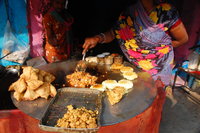
Rather than wedding flowers, for lunch we had a delicious street-food concoction of fried potato, chickpeas, beans, coriander and mango sauce all cooked to order and served in a bowl made of leaves. After eating, Megan tried to feed the bowl to a passing water buffalo. It expressed great interest in licking the last of the sauce from the bowl, but absolutely none in the leaves themselves. This is odd since, had the bowl been plastic it would have munched away quite happily.
We found a [very] local restaurant in a vaulted cellar that sold thali at £0.70 each, so we ate there one evening. Food was delivered to us by a small boy using his hands and was mostly cold (temperature) and very hot (spices). Drinking water was sloshed onto the table in a plastic jug identical to the one left in all the hotels next to the toilet for ablution purposes. The water came out of a 210L yellow plastic barrel labelled "JCB Hydraulic Fluid". The power went off just as the food was delivered (probably a good thing) but, being the only foreigners in the place, we got the candle; the locals were left to eat in the dark. What could possibly go wrong?
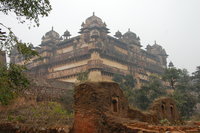
In terms of the actual reason for coming here, construction of the medieval palaces and temples in and around Orchha started in about 1530 and finished around 1627 after some dude called Bir Singh Deo built 52 of them in 22 years. There are too many palaces and temples to describe, but a few are worthy of special mention.
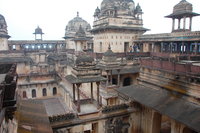
The Jahangir Mahal is the most impressive structure in the town. It was built by Mr Singh Deo as a gift for the visiting Mughal emperor when he came on a state visit - that's right, a gift!! Like everything else here, it is rather derelict now and populated by crows and parrots which, together with the misty conditions, lent a rather spooky air to the place. This was compounded by the fact that there seemed to be a group of Indians visiting who kept running around. Out of the corner of an eye, we would occasionally catch a fleeting glimpse of someone running across an opening or down a passageway, but we were never quite sure if they were there or not. Very horror genre!
Similarly, the Raj Mahal or Royal Palace is pretty impressive. It is more dilapidated than the Jahangir Mahal, but is notable for its stunning paintings showing hunting scenes and depictions of Vishnu in assorted guises.
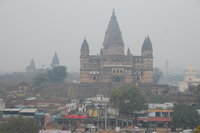
Another building of note is the strangely named Chatturbuj Mandir. This is a huge temple that towers over the town and is visible for miles (when it's not raining). When we visited, we were shown around by a deaf and dumb lad who explained the place and showed us the best spots to take photos all achieved utilizing a mixture of grunts and gestures. He proudly flourished his torch and guided us up narrow, impossibly steep, pitch dark staircases to emerge on the roof of the building. At one point the lad started flapping his arms vigorously and we wondered if he was threatening to throw himself off the roof if we didn't give him a generous tip (a novel if short sighted sort of hustle if ever there was one). It turned out that vultures nest in the more inaccessible parts of the towers which he wanted to show us. There was a definite feel of Notre Dame about the whole experience.
We tipped the lad generously for his efforts and he seemed very pleased. He mimed going to buy alcohol...
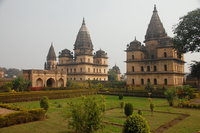
Of course, the sun came out the next day, so we wandered around mopping up the ruins we had not already seen (not literally) and taking a walk through the countryside finding long-lost remnants of buildings amidst the crops and tangled bushes. We were accompanied on our wanderings by a small boy who claimed to be a guide and by the constant whump of large-calibre ordnance detonating. Either there is a military practise range nearby or the impending Obama visit is causing more trouble than we expected.
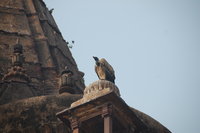
A particularly impressive set of ruins were the so called Chhatris or cenotaphs. Entry to these ruins is included in the palace ticket we had bought the day before, but which only lasts one day. Megan grumbled about us having to trudge back across town to pay another Rs250. The guard obligingly revealed that we could pay an entrance fee of only Rs50 each directly to him to access the Chhatris. Needless to say, we didn't receive any kind of ticket in return.
The Chhatris sit in the best maintained garden we have seen, all the work of one unusually diligent gardener. This chap offered to show us round, but we decided to go it alone. The cenotaphs have hidden staircases leading to the upper levels and we had to search pretty hard to find them. We really had to find them all as the gardener was keeping a close eye on us to see if we missed anything so that he could exercise his guiding skills. The tops of each cenotaph were home to a nesting family of vultures and these guys, along with thousands of parrots made the deserted buildings rather atmospheric.
The hotel owner in Orchha did not seem to employ a man who hammers. Presumably he didn't see the need since he had a baby girl that had the constant annoying noise angle covered. Before we checked out, he tried to persuade us to stay two more days on the basis that we would then be able to attend his baby daughter's first birthday party. He revealed that there would be about 500 guests! We politely declined and took the train to Khajuraho.
There is a single local train from Orchha to Khajuraho. The journey is 186km and costs £0.40 each. There is only a single class which it is probably polite to describe as "working man's class". The carriages were full of people wearing blankets and not wearing shoes, crouching on the seats and also in the overhead luggage racks. All of them were eating peanuts with their mouths open and throwing the shells on the floor. Occasionally we would see someone running across the fields (usually barefoot) towards the train. The driver would then stop the train in the middle of nowhere and wait for them. There seemed to be a game played by the driver as he would start the train moving again when he felt the runner had a sporting chance of making it to the last carriage. Half way through the journey, it turned out that the train split in two and that we were in the wrong half. We figured this out fairly easily and simply moved seats after observing the decoupling man to see which carriages we should use. After the split and about 5 miles into the second half of the journey, the train stopped again and a large number of Indians got off and started walking back the way we had come. So much fun for only £0.40!
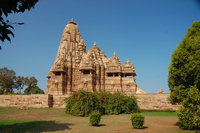
Khajuraho is famous only for its extensive temple complex; oh and it's aggressive touts, shop owners and tuk-tuk drivers. First off, we went to visit the large state tourist office in town. It is staffed by about eight people and provides absolutely no information whatsoever. They have no maps, no leaflets, no idea. What they did manage to tell us was mainly wrong. Steve wanted to go back and ask them what they thought their purpose actually was, but we decided they wouldn't know that either. They did manage to supply us with a very comprehensive information sheet and detailed scale drawings of...Siem Reap in Cambodia. Handy!
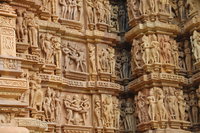
The Khajuraho temples are quite unique and very interesting. They were constructed by some dudes called the Chandellas over 1,000 years ago. They are made out of sandstone which means the carvings are very intricate and detailed. Their state of preservation is remarkable - both because of their age and because of the mistreatment they would invariably get here. There are some 85 temples in total, although only about 20-odd can be visited today. They are completely festooned with carvings of deities, common folk, animals and mythical creatures. Many of the carvings are of an erotic nature featuring various couplings between any and all of the aforementioned beings. No one knows why the carvings depict the scenes that they do, but there has been much speculation including that they could be a teaching aid or even perhaps a joke. Regardless, it is this erotic nature that has made the Khajuraho temples world famous. It does not seem to be in the Hindu nature to look too closely at the erotic aspects of the carvings. One guide was overheard to say "you have paid for it so I have to talk about them". The wall plaques discussing the carvings make no mention at all of this most unique aspect and the one leaflet we did find only says "composite figures and erotic couples touch the highest perfection in art tradition and is much figuratively speaking higher than the height of the Himalaya", which sort of makes sense. Mind you, the Brits aren't much better; the temples were rediscovered in 1838 by a rather prudish Victorian army officer (weren't they all?) named T.S.Burt, who described the carvings as "extremely indecent and offensive".
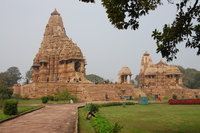
The temples sit on stone platforms some 10 to 15 feet above ground. It would be quite easy when trying to take a photograph to step backwards off the edge, particularly as there is a tendency to move back to try and take in the whole scene. There is, of course, no fencing. Since the temples were so impressive, we actually visited twice. The second time we took the audio guide and the commentary even warned about the risk of falling off the monuments. Our decision to visit twice was driven in part by the fact that the temples are set in very pleasant, well maintained gardens that the touts can't get into so it offers a sanctuary in the midst of a very annoying and rather boring mêlée of hustle.
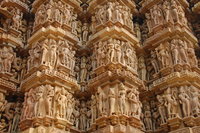
Today, the temples sit on the outskirts of the small, ancient village of Khajuraho and, being a UNESCO World Heritage site, draw tourists from around the world. The locals seem to have taken to tat-selling and tourist hassling like ducks to water. They are certainly much worse than anything we have witnessed anywhere else on this trip, which is a shame as the place could be rather pleasant otherwise. We did try to find out why the locals are so bad and it seems to be attributed to an indifferent tourist police, which is interesting and is perhaps testament to how effective they are everywhere else. Certainly the one time the police did put in an appearance, the botherers ran off! These touts are not so much a hassle as a tedium. They have invented two or three approaches to try and engage the tourist and absolutely everyone uses them. No one tries to come up with anything novel.
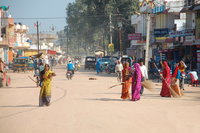
As a village, Khajuraho is rather dysfunctional, but blame for this should probably be laid at the feet of the ruins which have catapulted this place to fame. The town does not appear to have a functioning economy outside extracting money from tourists. There are two main streets at right angles; one is tarmac, the other is a muddy, rutted track. Traffic is allowed on the dirt track but not on the metalled road. It may only be a village, but there is a domestic airport and a soon to open international one too. Our tuk-tuk driver proudly told us that we would be able to fly directly from Europe, although this is hard to believe.
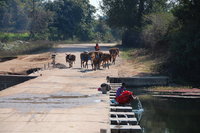
There is a Swiss bakery here that sells apple pie and great coffee and an Italian place that sells appalling coffee. There are also loads and loads of shops all selling unique antique items that can't be found anywhere else (except in all the other shops). It seems that, because the town plays host to some very old temples, the locals think we will buy anything as long as it is (or rather looks) old. One poor old chap's English only permitted him to say "I am antique, not available" and, as he limped around his shop picking up junk to show us, he added "I am accident". At one point, he tried to sell us an old plastic 110 format camera from the 1980s claiming it was an antique. We made our excuses and, as we wandered off down the street, his plaintive voice could be heard..."I am antique".
Our accommodation was called the Hotel Harmony and it is painted the most dis-harmonious lime green and orange imaginable. In common with everywhere we have stayed, if you want a fried egg, you have to specify if you want it turned half way through frying. This is known locally as "eggs one side" or "eggs two side". Unique to this hotel however, is their application of this principle to toast as well. Hence, daily we had to order "toast two side". We managed to wangle a fan heater here, but realised after a few days that more heat was generated by the plug and socket than by the heater. There are two sizes of mains plug in India, a low current version and a high-current one for things like...fan heaters. Now we know what happens when they fit the wrong plug. Actually, it is amazing the plug managed to melt since the power is off here about 50% of the time.
We spent about five days in Khajuraho which was probably a little too long, but the train we require only runs every few days. It did give us time to recuperate and eat large quantities of apple pie...and toast two side.
Next, we take the occasional overnight "sleeper" train from Khajuraho to Varanasi for our last major destination before turning and heading for home. We have been warned numerous times that Varanasi is a bit of an onslaught to the senses, but hopefully we are well prepared by now. Find out next time....
